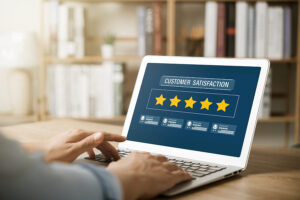our blog
Charity Event Follow-Up: 5 Actionable Tips To Get It Right
by Cary Schwartz
Picture this … It’s late on a Saturday evening, and you’ve just said goodbye to the last group of guests leaving your annual gala. You and your team begin taking down decorations, putting away tables and chairs, and commending each other on a job well done.
A months-long process has come to an end. The event you’ve been planning (and maybe even stressing over) for such a long time has been executed successfully, and it’s definitely a victory worth celebrating. But you may also feel like it’s time to leave the event behind and move on to other pressing projects to advance your cause.
Not so fast! You still have some important tasks ahead of you.
The days and weeks after an event are a crucial time to follow-up with your supporters. This provides an opportunity for you to further engage everyone who attended your event or contributed to it.
In this guide to charity event follow-up, we share five actionable tips you can apply after your next event.
Let’s begin!

Our first tip is a universal one that applies to all of the other tips we’ll discuss: be prompt!
After an event, you have the opportunity to capitalize on the memories and connections made during the event. Utilize these connections and memories of the event to drive more engagement with your supporters. But, your event will only be top-of-mind for so long.
Think of it this way: if you were at an event attendee, which of the following would feel more meaningful and leave you with a better impression of the organization that hosted the event?
A thoughtful “Thank you for attending!” message received two days after the event?
A thoughtful “Thank you for attending!” message received six months after the fact?
Clearly, the thank-you message sent a couple days after the event would feel more genuine and thoughtful, and much more likely to positively impact your view of the organization. By moving quickly like this after your event to complete your follow-up tasks, you’re demonstrating to everyone involved that they matter to your organization and that you’re eager to have them continue supporting your nonprofit for the long-term.
You can ensure a prompt follow-up by planning your post-event activities during the larger event planning process. Doing so will help you view your follow-up work as part of the larger effort that goes into a successful event, rather than a nice afterthought. Plus, you won’t be scrambling the day after your event to determine what sort of “thank you” messages you want to send out, or how you’ll secure support from people you interacted with at the event.

Begin your efforts with thanking everyone who made your event a success. Depending on the event, this may include:
- Corporate sponsors and community partners.
- Attendees and donors.
- Volunteers.
- Emcees, speakers, entertainers, and auctioneers
Before you resort to planning to send the same thank you note to everyone you want to show your appeciation to, determine the thank you strategies you can use to make each group feel seen and valued for their unique contributions.
Here are some strategies to consider:
- Match the thank you to the contribution: For instance, you might thank your event volunteers by sending them each a thank you note and a T-shirt branded to your organization. Or, for a major donor who contributed several luxury auction items, you could personally deliver a gift basket full of branded merchandise from your organization and products from local businesses. In many cases, a personal phone call is in order. Never underestimate how good a personal phone call makes someone feel. Showing gratitude on the same level as the contribution will empower you to communicate the impact that each individual had on your event and will also help you effectively manage the time and resources you have allocated for your charity event follow-up tasks.
- Leverage tech to give your thank-yous a creative spin: A handwritten thank you note is an effective tool for recognizing your supporters, but nowadays, it’s not your only option. Try creating thank you videos, sending eCards, or sharing supporter spotlights on social media or your blog. Not only will these strategies get your message of gratitude across, but they’ll also be unexpected and surprising for your supporters, making your nonprofit stand out from the crowd.
- Make it personal, no matter the thank you: No matter the size of your thank you or who it’s for, you should always do what you can to personalize it. Use your supporters’ first names and any specific information from the event, such as the donation amount contributed or hours volunteered to make the thank you message feel like it was carefully crafted for that individual. Whatever you do, don’t make the mistake that many have made and send out messages that have the wrong name on them, or messages that are clearly canned.
Recognizing your supporters in the right way is critical for building new relationships or strengthening continuing relationships. A thoughtful thank you can set a positive tone for future interactions and more contributions.

More than being a fun party to attend, your charity event should hold significance for your nonprofit’s cause. While you can communicate the purpose of the event during the occasion itself, it’s also important to showcase the outcomes of the event to your community.
Doing so can reinforce how this and other events are connected to your overarching mission and can inspire your supporters to attend future events or discover additional ways to get involved with your cause.
Here are a few things you can share with your community of supporters to demonstrate the impact of your event:
- Fundraising Results: Fundraising dollars are the fuel your organization relies on to do more good for its beneficiaries. Share what your fundraising goal for the event was and how much money you raised. Also, share how you plan to use the funds to further your cause.
- Videos and Photos From the Event: Events are great for making memories with your community. Share photos and videos from the big day to remind your supporters of the great times you had together. Pay special attention to how you craft your videos. According to Tectonic Video’s guide to nonprofit video storytelling, your videos should have a consistent and well-structured narrative with a clear beginning, middle, and end. Short, highlight reels from events often do very well as donors will watch the video through its entirety to see who they spot and to relive exciting moments. They may also feel compelled to share the video on social media or with those who were not able to attend, which further builds your brand and awareness for your cause.
- Beneficiaries’ Stories: If appropriate, you can also share how your beneficiaries were affected by your event; just make sure to get their permission first! For example, you might publish a blog post that includes an interview with a parent who is now able to enroll their child in your free daycare program thanks to the donations given at your recent event.
Reporting the results of your events will also be important for remaining accountable to your key stakeholders and planning ahead to make future events even better. Make sure you gather and organize all of your event data in one place so that you can easily pull insights to share during the charity event follow-up.

One of the best ways you can communicate to supporters that you care about them and their experience with your organization (and prepare for future events) is to seek feedback on the event experience.
You can solicit this feedback in a variety of ways. For example, you might call some of your top donors to ask them about what they thought of the event. Or, to get more general feedback, you might email out a short survey or share it on your social media profile.
However you decide to ask for feedback, make sure to ask open-ended questions. Instead of something like “Did you enjoy the event?”. Instead, opt for “What was your favorite part of the event?”.
Your attendees’ feedback in your charity event’s follow-up might encourage you to change small things about your upcoming events, like the entertainment or fundraising strategies you have planned. Or, you may be encouraged to try something totally new, like a hybrid or virtual charity event. Keep an open mind as you gather feedback and prepare to implement suggestions where you can.

The days and weeks after an event are the perfect time to invite your event attendees and other supporters to get involved with your nonprofit in a variety of ways. In your follow-up communications, share with your supporters what is on the horizon for your nonprofit and how they can lend their support. For example, you could encourage your supporters to:
- Attend Another Event: If your supporter enjoyed attending your event, chances are they’ll be interested in attending another! Try sending an email with a calendar of upcoming events and asking supporters to save the dates. You could even provide a special registration discount for returning attendees.
- Volunteer: Encourage event attendees to get on-the-ground experience with your mission by signing up to be part of your volunteering program. This will give them the chance to deepen their connection to and investment in your organization.
- Donate: While many of your event attendees will likely feel inspired to give to your nonprofit after your event, be careful not to extend a donation ask to someone who just contributed a gift before or during the event. This may leave a bad taste in their mouth.
- Learn More About Your Cause: Send event attendees educational materials, like your recently-published blog post or your annual report. This will encourage them to become more familiar with the particulars of your work and how they can continue to contribute.
- Follow You on Social Media: Keeping up with your organization on social media gives supporters an opportunity to see frequent updates on your cause and any upcoming campaigns or events. Plus, it’s an easy ask—all your supporters will need to do is click a button!
Make sure you personalize your requests for further involvement based on what you know about your supporters. For instance, if you know a major donor is interested in getting their entire family involved in your cause, you might want to let them know about an upcoming volunteering event. Alternatively, an event attendee might be most interested in reading your educational materials or signing up for your monthly giving program.
We recommend that you do not overlook the importance of performing charity event follow-up. Your relationships with your supporters depend on it, and these five tips can get you started.
Learn more about how Charity Dynamics can help increase your outreach and fundraising potential

